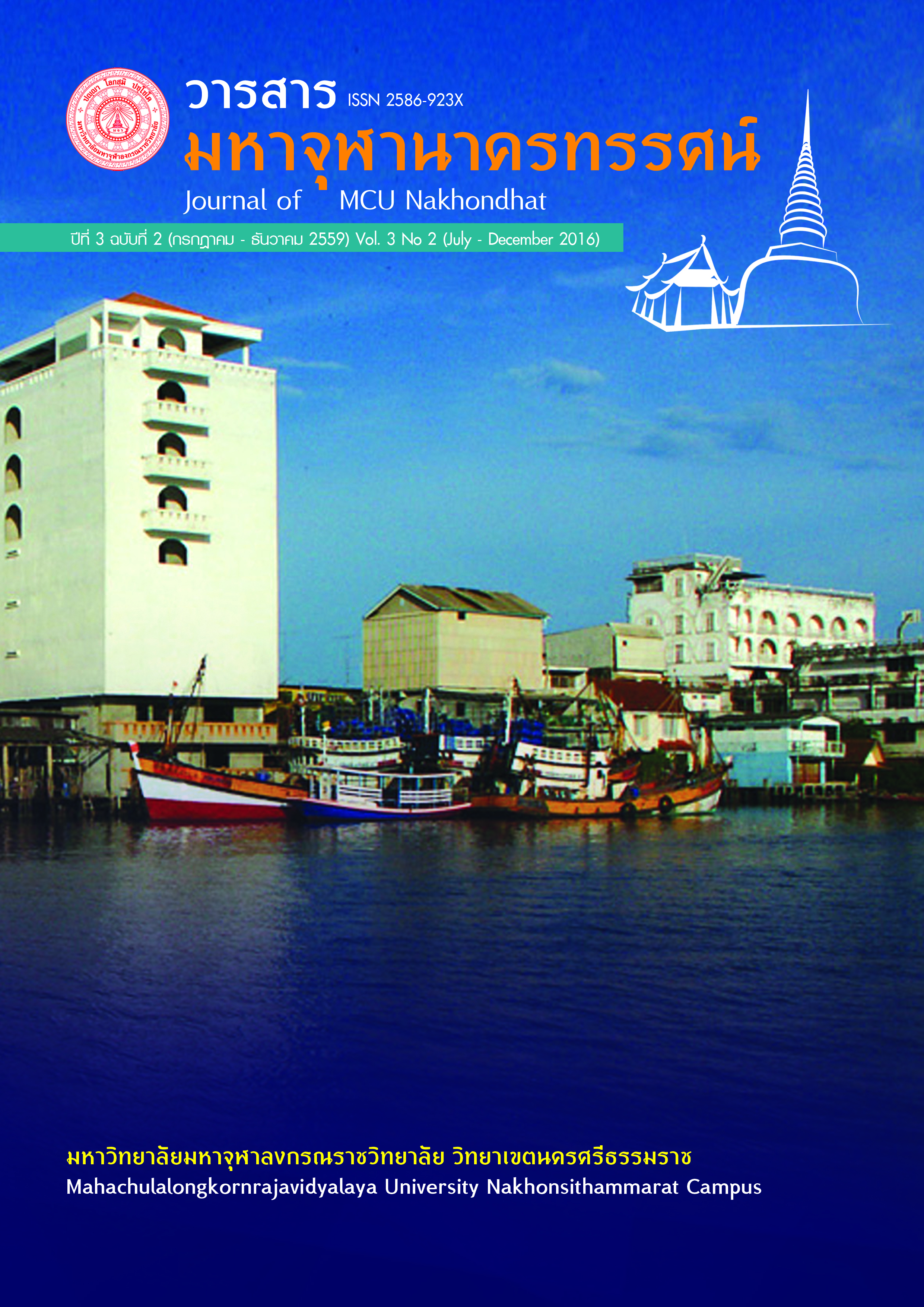ASELF PERFORMANCES OF GARAVADHAMMA PRINCIPLE OF STUDENTS IN KOBKARNAUKSA MULANITHI SCHOOL, HATYAI DISTRICT, SONGKHLA PROVINCE.
Main Article Content
Abstract
The objectives of this research were as follows 1. to study the self-performance according Gāravadhamma principle of students in Kobkansu ksamulanithischool, Hadyai district, Songkhla province. 2. to compare the self-performance according Gāravadhamma principle of students in Kobkansu ksamulanithi school, Hadyai district, Songkhla province in terms of sexes, class levels, average grades, parents’ occupations, the numbers of Buddhist activity participation and family statuses as differently and 3. to study the suggestion on the way to promote on Gāravadhamma principle of students in Kobkansuksamulanithi school, Hadyai district, Songkhla province. The population were students in primary school of Kobkansuksamulanithi school, academic year 2013, Hadyai district, Songkhla province, there are about 421 persons sample size according to Krejcie and Morgan’s table measurement, the samples were about 201 persons, stratified random sampling was used as cluster in rule of three then simple random sampling by numeral table sample. The instrument for data collection was questionnaire on self-performance according to Gāravadhamma principle of students in Kobkansuksamulanithi school, Hadyai district, Songkhla province, designed by the researcher of the co-efficiency at .950. The statistics were applied as follows; frequency, percentage, arithmetic mean, standard deviation, t-test, F-test, and to test the arithmetic mean in each pair by LSD method, (least Significant Difference).
The findings were as follows;
- The self-performance according to Gāravadhamma principle of students in Kobkansuksamulanithi school, Hadyai district, Songkhla province by overall in six aspects were at more level (
=3.70) when considered in each aspects from more to less found that the aspect of Patisantharagāravatā (respect in welcoming) was the highest mean (
=3.91) and followed up the aspect of Buddhagāravatā(respect the Buddha) (
=3.80) and the aspect of Sangagāravatā (respect the Sanga) was the lowest mean (
=3.54) and classified in terms of sexes, class levels, average grades, parents’ occupations, the numbers of Buddhist activity participation and family statuses found that by overall was at more level.
- The comparative result on self-performance according to Gārava dhamma principle of students in Kobkansuksamulanithi school, Hadyai district, Songkhla province in terms of average grades, and numbers of Buddhist activity participation found that there were different as statistically significance at 0.05, but in terms of sexes, class levels, parent’s occupation and family statuses found that there were not different as statistically significance at 0.05.
- The suggestion on the way to promote on self-performance according to Gāravadhamma principle of students in Kobkansuksamulanithi school, Hadyai district, Songkhla province found that the aspect of Sikkhāgāravatā(respect on education) was the highest frequency i.e. The students should be attention on the class as strictly, they should try to find new knowledge as usual, and they should respect and to be honor on teachers.
Article Details
References
พ.อ.ปิ่น มุทุกันต์. (2535). มงคลชีวิต ภาค 3. กรุงเทพมหานคร: โรงพิมพ์มหามกุฎราชวิทยาลัย.
พระบุญฤทธิ์ ทีปงฺกโร (หนูยิ้มซ้าย). (2556). การนำหลักคุณธรรมพื้นฐาน 8 ประการ มาใช้ในการดำเนินชีวิตของนักเรียนโรงเรียนจรัสพิชากร อำเภอเมือง จังหวัดนครศรีธรรมราช. กรุงเทพมหานคร: โรงพิมพ์มหาจุฬาลงกรณราชวิทยาลัย.
มหาจุฬาลงกรณราชวิทยาลัย. (2539). พระไตรปิฎกภาษาไทย ฉบับมหาจุฬาลงกรณราชวิทยาลัย. กรุงเทพมหานคร: โรงพิมพ์มหาจุฬาลงกรณราชวิทยาลัย.
ส่งศรี ชมพูวงศ์. (2552). ระเบียบวิธีวิจัยทางสังคมศาสตร์. นครศรีธรรมราช: โรงพิมพ์มหามกุฏราชวิทยาลัย.

